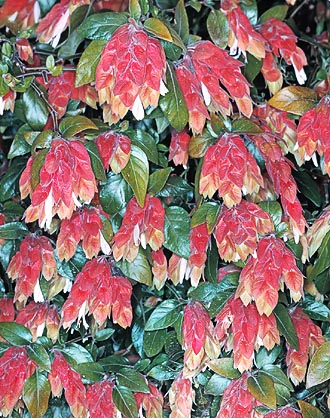Family : Acanthaceae

Text © Pietro Puccio

English translation by Mario Beltramini

Indoor plant also for gardens in mild climates © Mazza
The genus is dedicated to the Scottish botanist and horticulturist James Justice (1698-1763), the species to the American botanist Townshend Stith Brandegee (1843-1925).
Common names: “beloperone” (Italian); “false hop”, “Mexican shrimp-plant”, “shrimp-plant”, “shrimpbush” (English); “plante aux crevettes” (French); “Zimmerhopfen” (German); “planta camarón”, “lúpulo de interior” (Spanish); “camarão-vermelho”, “flor-de-camarão” (Portuguese).
Herbaceous or semi-woody shrub, evergreen, very ramified, which does not surpass, usually, the metre of height, it shows ovate leaves, slightly pubescent, long up to about 7 cm. The flowers are small, 2-3 cm long and of white colour, which come out inside a pendulous terminal spike, long lasting, formed by imbricate bracts, which, with the time, turn from green to dark red; the blooming goes on, continuously, from spring to autumn. The fruits are oblong capsules, of about 1,2 cm of length, containing ovoid seeds long about 3 mm.
Little exigent plant as for soil, it can be cultivated both in partial shade and in full sun, from tropical to temperate climates, where it acts as deciduous, as it can resist, for short time, to low temperatures up to -10 °C, with loss of the aerial part, but with fast recovery in spring. It is also cultivated in pot, in luminous position, for indoor decoration. It reproduces by seed, but, more frequently, by cutting.
Synonyms : Beloperone guttata Brandegee (1912); Calliaspidia guttata (Brandegee) Bremekamp (1948); Drejerella guttata (Brandegee) Bremekamp (1951).
